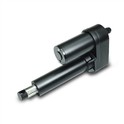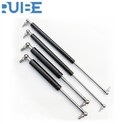Hey there! As a supplier of gas springs for furniture, I've seen firsthand how important it is to keep these little wonders in tip - top shape. Gas springs are like the unsung heroes of furniture, making our cabinets open smoothly, wall beds rise effortlessly, and bonnets on cars (in some cases) pop open easily. In this blog, I'm gonna share some cool tips on how to maintain a gas spring for furniture.
Understanding Your Gas Spring
First things first, let's get to know what a gas spring is. It's basically a cylinder filled with nitrogen gas and a small amount of oil. The gas provides the force to move the furniture part, while the oil helps with lubrication and damping. Different types of furniture need different gas springs. For example, a Kitchen Cabinet Gas Spring is designed to handle the relatively light - weight doors of kitchen cabinets, while a Bonnet Gas Struts used in cars or some heavy - duty furniture has to support a much larger load. And if you've got a wall bed, a Gas Spring for Wall Bed is engineered to make the bed go up and down smoothly without a hitch.


Regular Cleaning
One of the simplest yet most effective ways to maintain your gas spring is regular cleaning. Dust, dirt, and debris can accumulate on the surface of the gas spring over time. This not only looks bad but can also cause wear and tear. You can use a soft, dry cloth to wipe the gas spring down. If there's some stubborn grime, you can dampen the cloth with a little bit of mild soap and water. But make sure you dry it thoroughly afterward. Moisture can lead to rust, which is a big no - no for gas springs.
Inspecting for Leaks
Leaks are a major problem with gas springs. If the nitrogen gas leaks out, the gas spring loses its ability to function properly. You can inspect for leaks by looking for any signs of oil around the seals or the body of the gas spring. A small amount of oil on the surface is normal, as it's used for lubrication. But if you see a large amount of oil or a continuous drip, that's a sign of a leak. Another way to check is to listen for a hissing sound when the gas spring is in use. If you hear hissing, it could mean there's a leak in the gas chamber. If you suspect a leak, it's best to replace the gas spring as soon as possible.
Lubrication
Lubrication is key to keeping your gas spring working smoothly. The oil inside the gas spring provides some lubrication, but over time, it can break down. You can use a silicone - based lubricant to lubricate the moving parts of the gas spring. Apply a small amount of lubricant to the rod and the end fittings. Be careful not to over - lubricate, as too much lubricant can attract dust and dirt, which can cause more problems.
Checking the Mounting
The mounting of the gas spring is also crucial. If the gas spring is not mounted correctly, it can put extra stress on the spring, leading to premature failure. Check the mounting brackets regularly to make sure they are secure. If you notice any loose bolts or screws, tighten them up. Also, make sure the gas spring is installed at the correct angle. An incorrect angle can cause the gas spring to work harder than it should, reducing its lifespan.
Avoiding Overloading
Every gas spring has a specific load - capacity rating. It's really important not to overload the gas spring. For example, if you're using a gas spring for a kitchen cabinet door, don't try to hang a heavy object on the door. Overloading can cause the gas spring to fail quickly. It can also be dangerous, as a failed gas spring can cause the furniture part to fall suddenly.
Storage
If you're not using the gas spring for a while, proper storage is essential. Store the gas spring in a dry, cool place. Avoid storing it in direct sunlight or in a place where it can be exposed to extreme temperatures. Extreme heat can cause the gas inside the spring to expand, while extreme cold can make the oil thicken, both of which can affect the performance of the gas spring.
When to Replace
Even with the best maintenance, gas springs will eventually wear out. There are some signs that it's time to replace your gas spring. If the gas spring is no longer providing enough force to open or close the furniture part, or if it's making a lot of noise when in use, it's probably time for a new one. Also, if you've tried all the maintenance steps and the gas spring still isn't working properly, replacement is the way to go.
Why Choose Our Gas Springs
As a supplier, we take pride in offering high - quality gas springs for furniture. Our gas springs are made from top - notch materials, ensuring durability and long - lasting performance. We've got a wide range of gas springs to suit different furniture needs, whether it's for kitchen cabinets, wall beds, or bonnets. And we're always here to provide support and advice on how to maintain your gas springs.
If you're in the market for gas springs for your furniture, or if you've got any questions about gas spring maintenance, don't hesitate to reach out. We're more than happy to have a chat and help you find the right gas springs for your project. Let's work together to make your furniture function at its best!
References
- Industry standards and guidelines for gas spring manufacturing and maintenance.
- Years of experience in the gas spring supply business.






